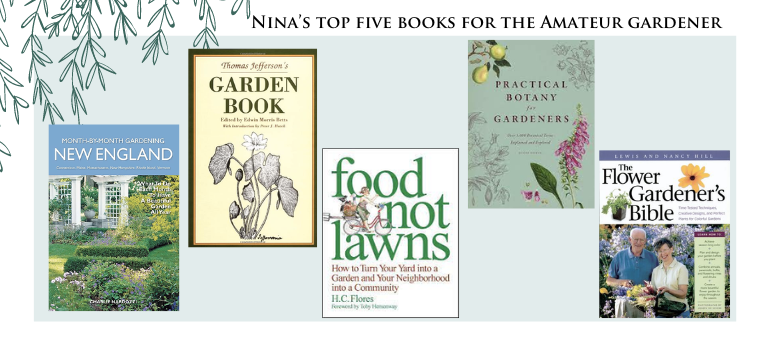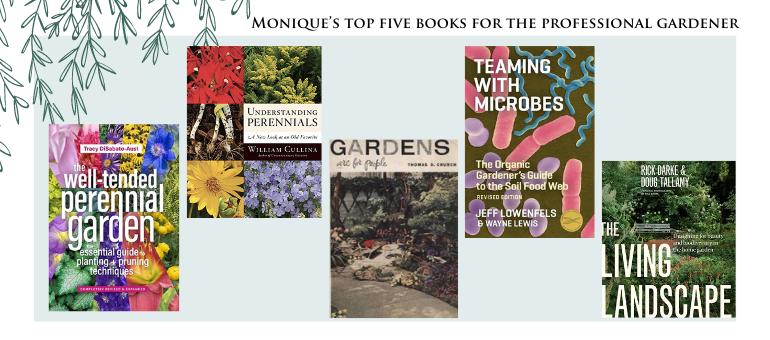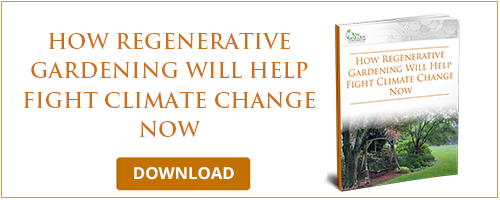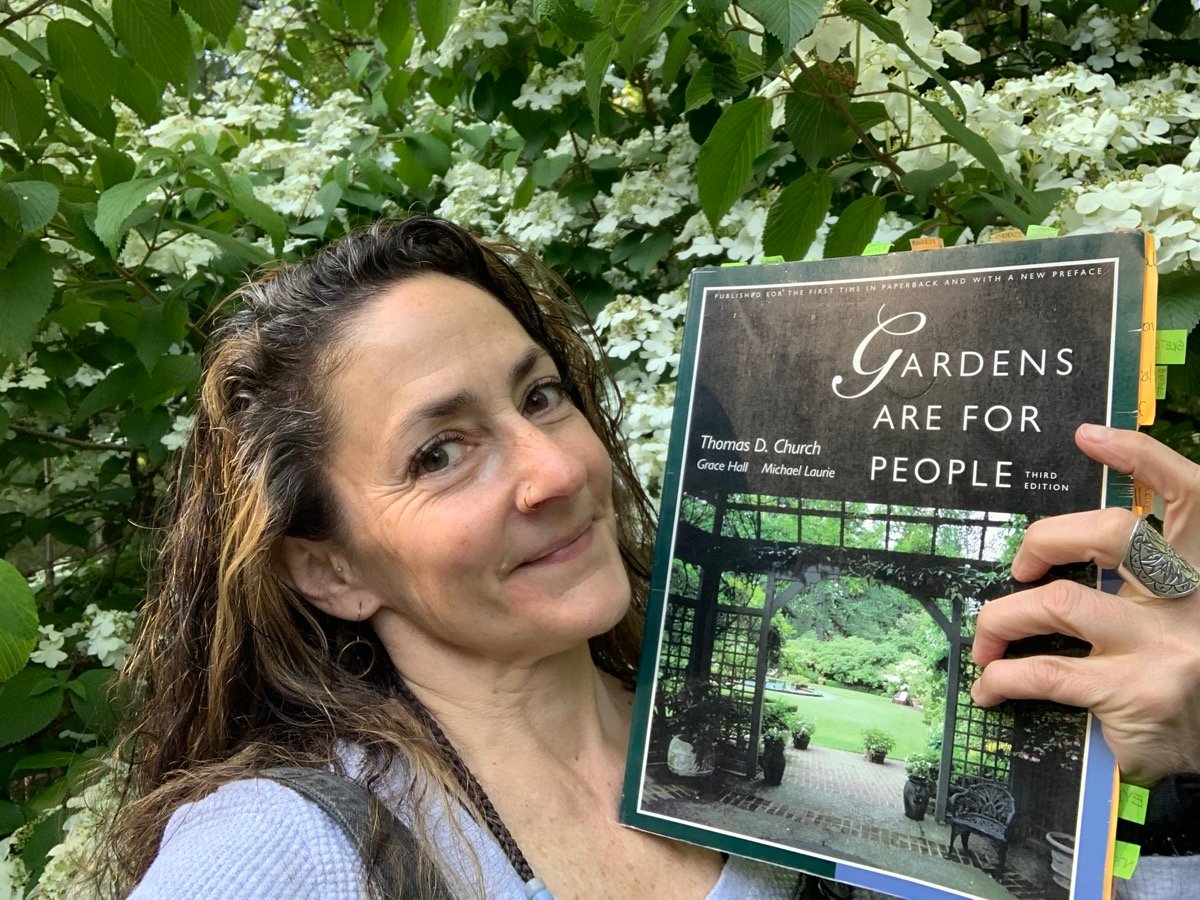Gardening is a lifelong quest for knowledge. Whether you’re experienced or just starting out, a good book, or better yet, a library of books can be an invaluable resource. But in a sea of gardening picture books that only express a snapshot of pretty, how do we know as professionals and amateur gardeners that we are reading books with good information?
How to Choose the Best Books for Your Gardening Library: Key Questions to Consider
The first step in building your library is to determine what questions you’re looking to answer. For example, if you’re asking yourself, ‘How can I make my yard more inviting?’ A great book to reach for would be Monique’s book, “Stop Landscaping, Start Lifescaping.’ Her book provides valuable insight and practical advice for homeowners looking to create a more meaningful connection to their outdoor space.
Here’s a list of some other common questions to consider when adding to your collection.
What is your level of experience with gardening? Are you a beginner, intermediate, or advanced gardener? Depending on your experience level, you may want to select books that offer a different level of complexity in terms of gardening techniques and terminology.
What type of gardening do you enjoy? Are you interested in growing vegetables, flowers, herbs, or a combination? Consider selecting books that focus on the types of plants and gardening practices that you are most interested in.
What is the climate and soil like in your region? Different regions have different soil types and climates that can affect what plants grow best. Look for books that are tailored to your specific region and can provide guidance on what types of plants are best suited to grow in your area.
What is your budget? Gardening books can range in price from a few dollars to over a hundred dollars. Consider your budget and look for books that are within your price range or borrow them from your local library.
What type of information are you looking for? Are you looking for books that focus on gardening techniques, plant identification, garden design, or a little bit of everything?
Consider your specific interests and look for books that provide the information you are looking for.
Thinking about the answers to these questions is definitely helpful, but sometimes a recommendation from a professional or a friend can be just as valuable.
Here are our top ten books that enable homeowners to improve their gardening skills while transforming their experience.
Nina’s top five books for the Amateur gardener

New England Month-by-Month Gardening: What To Do Each Month To Have a Beautiful Garden All Year by Charlie Nardozzi
Why Nina likes this book: Charlie’s step-by-step guide provides simple, straightforward action items for gardeners living in New England. From growing annuals and perennials to trees and vines, this book has you covered. And, the best part is, all of the information is broken down by month so that no matter what time of year, you’ll know what steps to take to make your garden bountiful and beautiful.
Thomas Jefferson's Garden Book by Thomas Jefferson
Why Nina likes this book: “Thomas Jefferson's Garden Book” is an excellent read for anyone interested in gardening, history, or both. This book gives the reader direct access to detailed journal entries Jefferson penned himself. You’ll learn about which plants he grew at Monticello, weather conditions he encountered and methods he experimented with. This book reflects his spirit of curiosity and innovation. He shares thoughts on everything from seed-saving to garden design. The reader gains insights into the gardening practices of the past while also learning from one of the most influential figures in American history.
Food Not Lawns: How to Turn Your Yard into a Garden and Your Neighborhood into a Community by H.C. Flores
Why Nina likes this book: "Food Not Lawns" is a book that offers an alternative perspective on the use of land, encouraging readers to transform their lawns into food-producing gardens. "Food Not Lawns," provides inspiration and practical knowledge for creating your own productive garden and contributing to a more sustainable food system. The book also touches on broader issues related to food security, community building, and environmental sustainability, making it a thought-provoking read for anyone interested in the intersection of food and society. Whether you're an experienced gardener or just starting out, "Food Not Lawns" can help you reimagine your outdoor space and make a positive impact on your community and the planet.
Practical Botany for Gardeners: Over 3,000 Botanical Terms Explained and Explored by Geoff Hodge
Why Nina likes this book: "Practical Botany for Gardeners" was recommended to Nina by her crew lead, Nat MacLean last year. It’s an essential read for anyone who wants to deepen their understanding of plants and improve their gardening skills. The book provides a comprehensive overview of plant biology and ecology, with a focus on practical applications for gardeners. You’ll learn about plant anatomy, physiology, and reproduction, as well as soil science, plant nutrition, and pest management. Whether you're a beginner or an experienced gardener, "Practical Botany for Gardeners" can help you develop a deeper appreciation and understanding of the plants that make our world so rich and diverse.
The Flower Gardener’s Bible by Lewis Hill
Why Nina likes this book: “The Flower Gardener’s Bible” is a comprehensive guide to flower gardening covering everything from selecting the right plants for your garden to planting and caring for them. Lewis’ writing is easily digestible and accessible to novice and experienced gardeners alike. Although this book was published twenty years ago, the information contained within it’s binding is ever relevant and will remain a valuable resource for years to come.
Monique’s top five books for the professional gardener

The Well Tended Perennial Garden by Tracy DiSabato-Aust
Why Monique likes this book: While Monique has read this book cover to cover, what she loves most isn’t unearthed until the second half. DiSabato-Aust provides the reader with an encyclopedia of perennials that spells out when to prune them, how to divide them and how to get them to perform and thrive. The first half shouldn’t be disregarded (It’s about how to build a garden - which is certainly helpful), but the encyclopedia is phenomenal.
Understanding Perennials by William Cullinna
Why Monique likes this book: William Cullinna is an experienced horticulturist and former director of the Garden in the Woods in Framingham, Massachusetts. And, Monique knows first hand how talented and knowledgeable Cullinna is because at one point, he was her teacher! The book is a comprehensive guide to perennials, covering everything from selecting the right plants for your garden to planting and caring for them, as well as dealing with common problems that arise. Cullinna provides in-depth information on each plant, including its growth habits, soil and light requirements, and how to propagate. It’s a book you will reference over and over again for years to come.
Gardens are for people by Thomas Church
Why Monique likes this book: First printed in 1983, this book features black and white photos. Thomas was a famous landscape architect. The book provides information about how to look at a site, the basics of design principles and the differences of architecture and why humans are so drawn to gardens. It is a great book for anyone interested in design. In fact, it was a required book for Monique’s graduate work.
Teaming with Microbes by Jeff Lowenfels and Wayne Lewis
Why Monique loves this book: Monique took a class given by Elaine Ingham, who popularized the idea that soil is alive and teaming with organisms that interact with each other to form a dynamic ecosystem. It’s a complex science, but the authors of this book break it down in under 200 pages so that home gardeners and professionals can understand. “Teaming with Microbes,” provides practical advice on how to improve soil health using organic methods like composting, cover cropping and crop rotation.
The Living Landscape by Rick Darke and Doug Tallamy
Why Monique loves this book: “The Living Landscape” is an essential read for anyone interested in creating a beautiful and biodiverse home garden that is both aesthetically pleasing and environmentally beneficial. Rick is a designer and Doug is an entomologist, together they set the stage for really beautiful and sustainable landscapes.
Grow your knowledge
As much as pictures are enticing and inspiring, to become a good gardener, you need to read words! There’s something about reading the work of another gardener, designer or landscape professional to create a deeper understanding. Gardening is not an exact science, it takes commitment to not only doing but reading as well.
In summary, any of these ten gardening books would be a perfect addition to your library. Each offers a wealth of information and advice to help you grow a beautiful and productive garden.
So, what’s your favorite gardening book? Leave a comment below. We would love to hear from you!
If you are interested in regenerative gardening, please download our eBook: How Regenerative Gardening will help Fight Climate Change.






Leave a comment